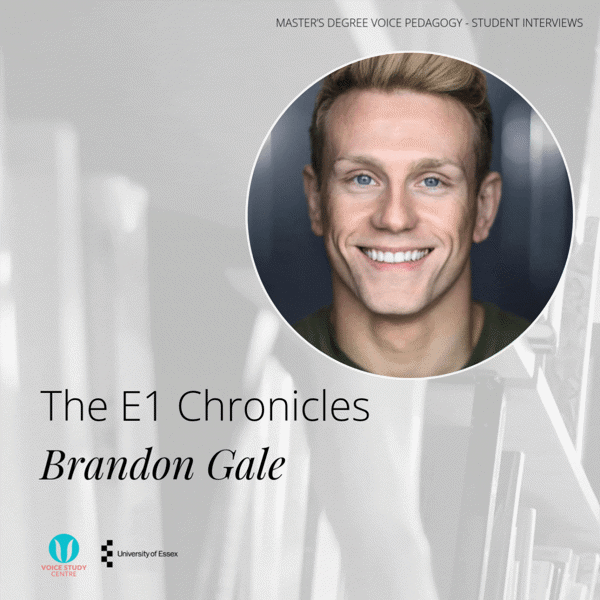Recently, I saw a comment on social media from a singer who had been advised to lift her chin, as if ‘singing to the balcony', to assist her with producing a belt quality. She felt the position was helpful and wondered why. Her question launched an avalanche of opinions on social media.
This is not the first time I have thought about chin position and singing. If you know me, it will come as no surprise that this topic has previously kept me awake at night! The process of working through the benefits or limitations of a particular chin position requires drawing from knowledge of anatomy, physiology, acoustics, and even the field of swallowing. It’s a long process to think through all the possibilities and ramifications.
I am very lucky to have conducted over 20,000 endoscopic examinations and can speak from experience about the pharyngeal and laryngeal changes I’ve observed when a patient makes even small cervical adjustments. It is common practice to ask a patient to adjust the position of their chin to enhance some aspect of the endoscopic examination. Chin up and forward, for example, opens the pharynx and gives the examiner a clearer view of the larynx. However, ‘up’ and ‘open’ is not always what is needed. In fact, enhanced resonance occurs when the vocal tract has some narrowing.
Changes in cervical posture create internal changes in the length and overall dimensions of the vocal tract. But what are the consequences of these changes? From a physiological perspective, when the chin is tipped upwards, the tongue goes along for the ride, and is also pulled up in the same direction. The hyoid and larynx are attached to the tongue and are likewise pulled upwards. The raised position of these structures shortens the vocal tract.
From an acoustics perspective, a shortened vocal tract is a well-known feature of belt voice quality (Steinhauer et al., 2017) that assists in the creation of a favourable acoustic environment. The pitch a person is singing dictates the frequency of the harmonics, but the overall length of the vocal tract, as well as the phonetic articulatory position of the tongue and jaw, largely determines their relative amplitude or energy. Regions of greater energy are known as formants. Formants can be adjusted by modifying the length of the vocal tract or by changing the vowel, among other things. Belters tend to enhance their bright chesty sound by raising the first formant (F1), so it is above the second harmonic (H2). This ‘belting magic’ is accomplished by shifting toward a brighter vowel (one that is produced with a higher tongue position in the mouth), by shortening the vocal tract, or a by using a combination of these strategies.
Another acoustic consideration involves two sets of pockets deep in the pharynx. The first of these spaces, the valleculae, is located between the tongue and the epiglottis (Fig.1). While it is a singular pocket, physicians often refer to the portions that extend into the right or left side of the pharynx in a singular manner (vallecula). Although it is a singular pocket, it is generally listed using a plural form of the word – valleculae. Anatomy is sometimes quirky like that. Though not entirely accurate, in this writing I will refer to it with its plural form. The valleculae are a common location where food can stick during swallowing. In addition to being an annoying catch-all for a person’s breadcrumbs, the valleculae act as an antiresonator when they open, reducing sound energy in a very important frequency range – below 4 kHz (Feng & Howard, 2021). The figure below shows the right and left regions of the valleculae in a superior view. It also shows the general location of the valleculae between the epiglottis and the back of the tongue in the image on the right.
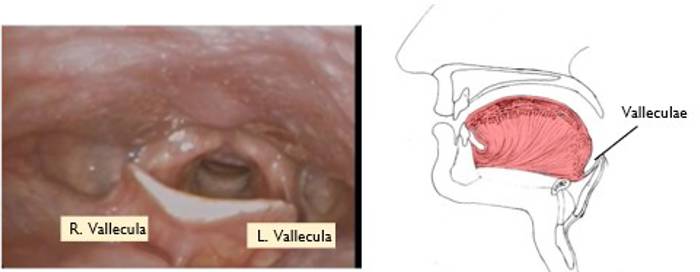
Frequencies in the range of 2-4 kHz are important to the production of singer’s formant (Sundberg, 1974, 1995). When singers boost spectral energy in this range of frequencies, it creates a ringing quality that helps with projection and adds to the brilliance of the tone. Research has shown that western classical singers, particularly males, often use the singer’s formant to achieve a robust ringing sound. So how do the valleculae contribute to the production of the singer’s formant?
The volume, or size of the valleculae, is constantly changing due to its proximity to the tongue. Each vowel a person makes causes a shift in the tongue position that affects the overall volume of the valleculae. The vowel /i/ pulls the tongue forward and increases the volume of the valleculae, while the vowel /a/ pulls the tongue back, thereby reducing its size.
When the volume of the valleculae is large, its antiresonance properties work against the singer who is trying to create a ringing voice quality. In this case, ‘open’ is not necessarily better. In fact, vocal tract modelling studies have demonstrated that a reduced volume, or closure of the valleculae, results in a boost in spectral energy below 4 kHz that may play a significant role in producing singer’s formant cluster (Feng & Howard, 2021).
Figure 2 is a picture of the pharynx and larynx during an endoscopic exam. You can see how the choice of vowel affects not only the position of the epiglottis but also the size of the valleculae. The image on the left shows a person saying the vowel [a]. Notice the tongue pulled back in the lower half of the image. In addition to closing the valleculae, production of back vowels also retroverts the epiglottis over the larynx. The image in the middle shows the [e] vowel with a partially narrowed valleculae and partially retroverted epiglottis. The [i] vowel, in the image on the right, clearly shows a very open valleculae as well as a wide open epilarynx. The constantly changing landscape of the tongue and valleculae has led researchers to look for other explanations for the source of singer’s formant cluster. Singer’s formant cluster is present regardless of the vowel. In the 1970s Sundberg proposed that singer’s formant was due to a narrowed epilarynx, among other things. But as we can see from these images, the epilarynx is also a constantly changing space – moving with every vowel. If a narrowed epilarynx is responsible for boosting sound energy in the 2-4 kHz region, wouldn’t we hear it every time someone narrows that space during production of an [a] vowel?
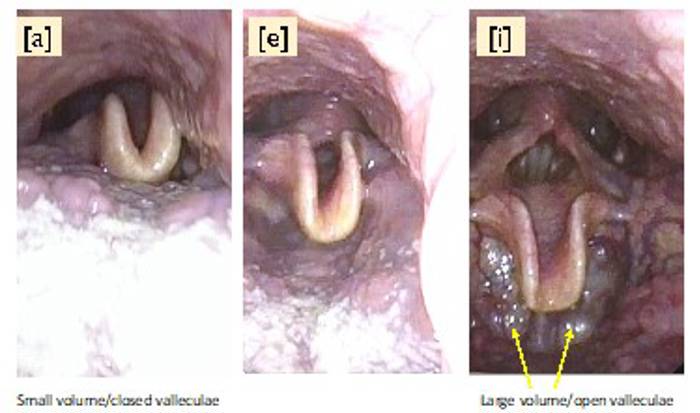
This raises some interesting questions about how people produce singer’s formant cluster and how they might reduce the antiresonances of the open valleculae since the pharyngeal and laryngeal shapes vary so much from one vowel to the next. This is where knowledge of swallowing is helpful. When a person experiences foods sticking in their valleculae, it is often attributed to a weak tongue. The tongue is meant to push backwards during a swallow to assist with moving food and liquids through the pharynx towards the esophagus. A strong tongue will move backwards quickly and efficiently enough to prevent foods and liquids from sticking in the valleculae. People who have trouble with this are often advised to ‘tuck the chin’ prior to and during swallowing to naturally position the tongue posteriorly into the pharynx. This simple trick can be a ‘game changer’ for the dysphagia patient as it naturally closes the valleculae. Similarly, a tucked chin during singing reduces the volume of the valleculae and theoretically reduces the antiresonance properties of the open cavernous space.
Tucking the chin is not the only way a person can reduce the volume of the valleculae. The posterior third of the tongue, or back of the tongue, can function rather independently from the front two thirds. In fact, it develops separately from the front of the tongue in utero and has its own sensory innervation that is very closely linked to swallowing. When a person swallows, the front of the tongue remains forward in the mouth while the back third of the tongue pulls backwards into the pharynx. Many singers learn to retrovert the back third of the tongue to close the valleculae while maintaining a fronted tongue in the mouth. These oppositional tongue movements are very useful, and many singers employ this strategy without conscious awareness.
I’m always surprised by how closed the vocal tract really is when I perform an endoscopic examination on a fantastic singer. The tongue is the most flexible structure in the vocal tract. It stands to reason that mastery of its movements is paramount for singing. Some singers retrovert not only the back of the tongue, but may inadvertently pull the entire structure backwards, leading to sounds and conditions that are recognized by teachers as problematic. However, a completely relaxed tongue may eliminate a person’s resonance strategy.
Figure 3 shows one of my research subjects producing the vowel [i] without a retroverted back of the tongue (left image) and with it (right image). Notice how the front of the tongue remains high and forward in the mouth in both images. This subject demonstrated independent control of the back of her tongue, and she eliminated the antiresonance properties of the valleculae. This strong tongue gesture results in the creation of a very robust ‘meaty’ sound with clear organization of energy in the singer’s formant region. I named this strategy lingual anterior to posterior narrowing, or APN.
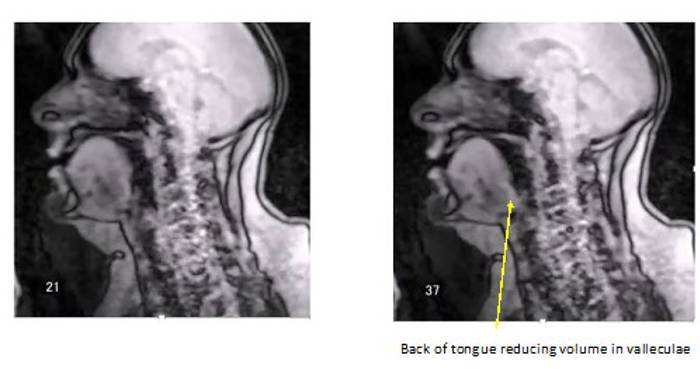
Why doesn’t everyone sing with a tucked chin if that’s such a helpful position? Wouldn’t a ringy quality be useful for all singers? Not necessarily. Some singers prefer a non-ringy quality while others use an even brighter timbre often referred to as 'twang'. Twang is created using a completely different strategy.
On the posterior side of the larynx are two additional pockets called the piriform sinuses (Fig. 6). Like the valleculae, these pockets act as antiresonators when their volume is large. Instead of reducing spectral energy in the singer’s formant region, they do so above 5 kHz. Conversely, when the piriforms narrow, there is a boost in energy in the same frequency range (Arnela & Ureña, 2022; Dang & Honda, 1997; Radolf, 2016). Singers find benefits in both the open and closed piriform positions. When they are open, the sound is warm and dark because of the reduction of energy in the buzzier high frequencies. It is common for western classical singers to use APN in combination with open piriforms to create a timbre that is both ringy and warm. When the piriforms close, the sound becomes brighter, and some might even say 'edgier', due to the boost in spectral energy above 5 kHz. Both are useful depending upon the desired timbre.
Singers can control the volume of the piriforms by contraction or release of the pharyngeal constrictor muscles. The pharyngeal constrictors are three circular muscles that give the throat its basic shape (Fig. 4).
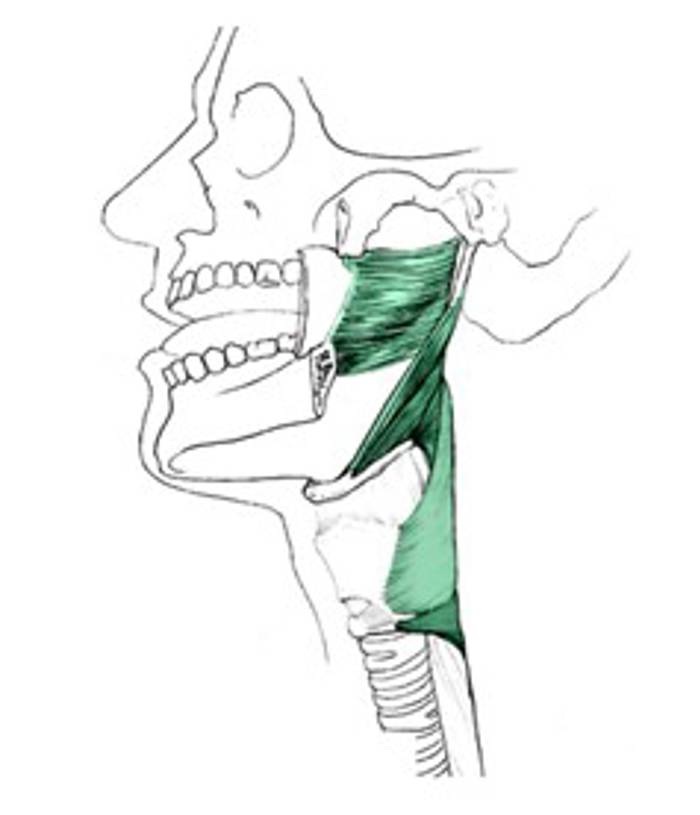
The pharyngeal constrictors insert at the midline of the posterior throat. They have attachments near the jaw and to the hyoid, thyroid, and cricoid. They are essential for swallowing. As their name implies, the pharyngeal constrictors narrow during swallowing to push foods and liquids through the pharynx into the esophagus.
Their action is more complicated than a simple narrowing manoeuvre, however. When they contract, they also elevate the larynx, an action that is essential for the esophagus to open in preparation for the bolus to enter. Pharyngeal narrowing via the pharyngeal constrictor muscles is always accompanied by a lift of the larynx due to their muscular attachments at the hyoid, thyroid, and cricoid cartilages. I named this lateral to medial narrowing of the pharynx, or LMN. Figure 5 illustrates the pharyngeal constrictors in released (left) and contracted (right) positions. Also note the elevation of the larynx in the contracted position on the right.
The degree of laryngeal elevation is directly proportional to the amount of LMN the singer chooses to use. A significant use of LMN results in very narrowed pharynx at the level of the mouth and larynx and a very high laryngeal position. LMN is incrementally lost as the larynx lowers and pulls the contraction of the pharyngeal constrictors out. Most singers who use LMN find their ‘Goldilocks timbre’ by using a moderate amount of narrowing with a slightly elevated laryngeal position.
An endoscopic view of the piriforms is noted in Figure 6 demonstrating large volume (open) in the image on the left and low volume (closed) configuration in the image on the right.
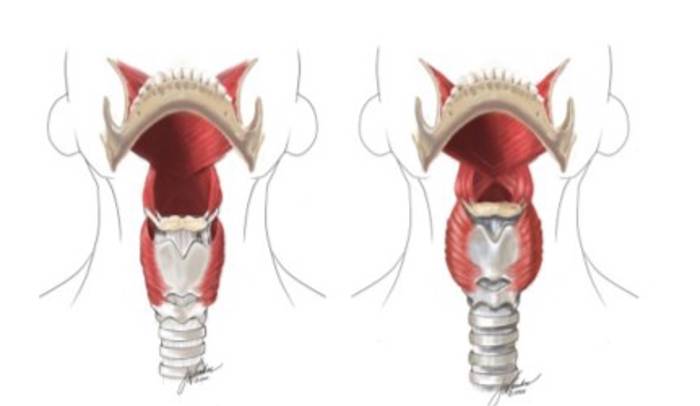
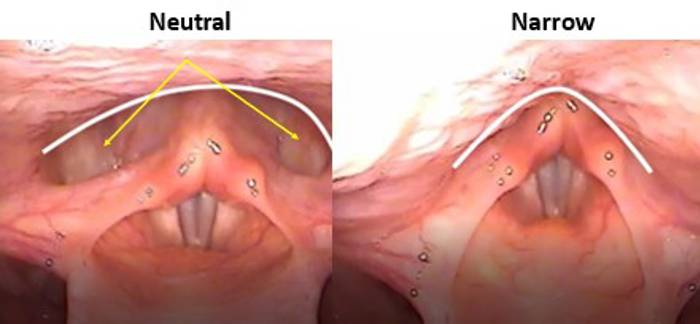
A narrowed pharynx is a common feature noted during endoscopic examinations of belters. It has also been observed during production of twang (Obert et al., 2019; Perta et al., 2021; Titze, 2022). Both belting and twang have also been noted to have a higher laryngeal position than those observed in western classical singing, indicating that LMN may be an identifying feature of these qualities. The chin up position may assist those who use LMN as their resonance strategy in the prevention of larynx lowering and in the loss of pharyngeal constrictor contraction.
It may surprise you to learn that many classical sopranos use LMN as their brightening strategy. The pharyngeal constrictors narrow in the high range for all singers in their highest pitches. Researchers indicate that LMN at the top of the range likely assists with increasing the length or tension of the folds as the relationship between the laryngeal cartilages changes with the upward pull of the larynx. In fact, a person cannot sing high notes without pharyngeal narrowing, particularly in the upper third of their range. Singers are often surprised by just how narrow the pharynx is in the upper range. Because soprano repertoire is often written in the high range, it makes sense that they would use LMN as their brightening strategy.
I have often observed that sopranos who try to lower the larynx too much may have a ‘woofy’ quality, one that lacks brilliance. By reducing the lowered larynx position the singer can enjoy the natural benefit of pharyngeal narrowing in the high range. The tendency for sopranos to use LMN may indicate why they have not been found to demonstrate singer’s formant cluster (Weiss et al., 2001). There are always exceptions to everything. Some sopranos do lean more heavily into the use of APN. Renee Fleming, for example, exhibits a dark, ringy quality that nobody would describe as extremely bright. The benefit of APN is that singers may pair it with any laryngeal height, whereas LMN is limited to a neutral or higher laryngeal position.
One of the issues in our profession is that we have assumed that all bright sounds are created in the epilaryngeal space and have lumped them all under the umbrella of ‘twang.’ APN and LMN are not only physiologically different, but they are also perceptually and acoustically distinct and with significant considerations for how chin and laryngeal height can support or undermine their effective use. Singers who use APN may benefit from tucking the chin. Singers who use LMN may benefit from one that is raised. As a voice teacher, it is my job to help students identify the postural and laryngeal height positions that support their timbral choices.
References:
Arnela, M., & Ureña, D. (2022). Tuned two-dimensional vocal tracts with piriform fossae for the finite element simulation of vowels. Journal of Sound and Vibration, 537. https://doi.org/10.1016/j.jsv.2022.117168
Dang, J., & Honda, K. (1997). Acoustic characteristics of the piriform fossa in models and humans. The Journal of the Acoustical Society of America, 101(1), 456–465. https://doi.org/10.1121/1.417990
Feng, M., & Howard, D. M. (2021). The Dynamic Effect of the Valleculae on Singing Voice – An Exploratory Study Using 3D Printed Vocal Tracts. Journal of Voice. https://doi.org/10.1016/j.jvoice.2020.12.012
Obert, K. (2023). Essential Vocal Pedagogy, Course Workbook
Obert, K., Ballantyne, C., & Ragan, K. (2019, January). NATS Chat: Getting the Twang of It. https://youtu.be/KHjbqUYrb04
Perta, K., Bae, Y., & Obert, K. (2021). A pilot investigation of twang quality using magnetic resonance imaging. Logopedics Phoniatrics Vocology, 46(2), 77–85. https://doi.org/10.1080/14015439.2020.1757147
Radolf, V. (2016). Sensitivity of Acoustic Resonance Properties to a Change in Volume of Piriform Sinuses. Applied Mechanics and Materials, 821, 671–676. https://doi.org/10.4028/www.scientific.net/amm.821.671
Sundberg, J. (1974). Articulatory interpretation of the “singing formant.” The Journal of the Acoustical Society of America, 55(4), 838–844. https://doi.org/10.1121/1.1914609
Sundberg, J. (1995). The singer’s formant revisited. Department for Speech, Music and Hearing Quarterly Progress Status Report , 36(2–3), 83–96. http://www.speech.kth.se/qpsr
Titze, I. (2022). The Acoustic Characteristics of Vocal Twang. Journal of Singing, 78(5), 613–614. https://doi.org/10.53830/lkzs7620
Weiss, R., Brow, W. S., & Morris, J. (2001). Singer’s Formant in Sopranos: Fact or Fiction? Journal of Voice, 15(4), 457–468.


